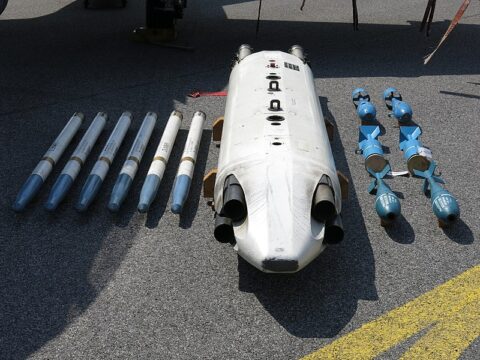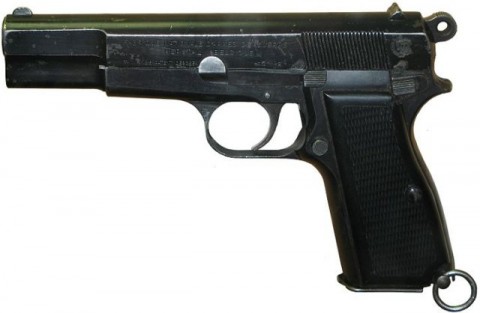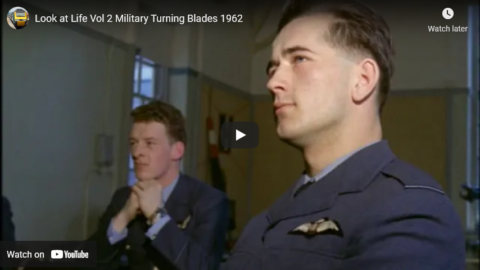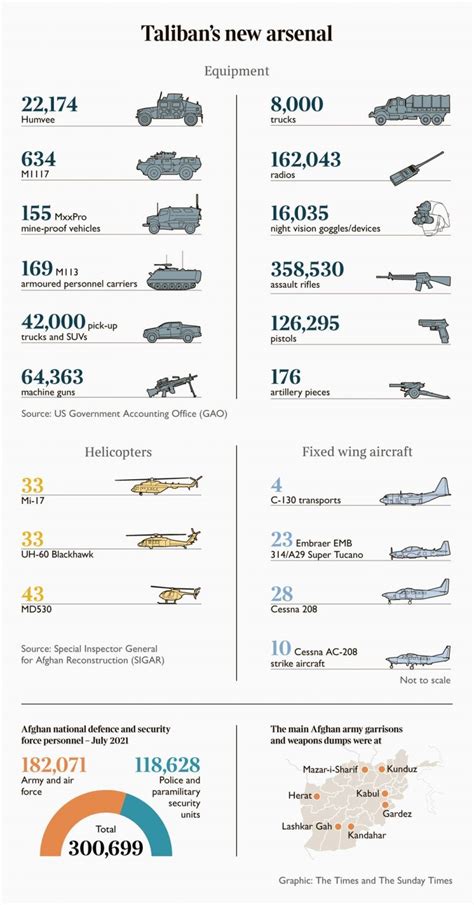Real Time History
Published Jan 5, 2024In 1965, tens of thousands of US troops are heading for war in Vietnam. Backed up by B-52 bombers, helicopters and napalm, many expect the Viet Cong guerillas to crumble in the face of unstoppable US firepower. Instead, in the jungles and swamps of Vietnam, the Americans discover combat is an exhausting slog in which casualties are high and they rarely get to fire first.
(more…)
May 16, 2024
Search and Destroy: Vietnam War Tactics 1965-1967
February 29, 2024
Ukraine asks for mothballed Canadian missiles that should have been destroyed 20 years ago
In The Line, Alex McColl makes a case against granting a Ukrainian request for obsolete CRV7 70mm air-to-ground rockets:

An SUU-5003 bomblet dispenser with six CRV7 air-to-ground rockets (left) and six BDU-33 bombs (right).
Photo by Boevaya mashina via Wikimedia Commons.
Canadian parliamentary committees — and even the leader of the official opposition — are endorsing a request by the Ukrainian military to send that beleaguered country thousands of mothballed rockets that have not been adequately stored or maintained. The plan has received nothing but approval from Canadians; however, according to multiple sources I have interviewed, the rockets in question are probably useless. In a worst case scenario, a few could go off and hurt or kill the Ukrainians trying to jury rig them into a short-range rocket artillery weapon.
This is about Canada’s stockpile of expired CRV7 rocket motors, which were slated for environmentally responsible disposal twenty years ago. Despite this, these weapons are being requested by the Ukrainian military, which is desperate for any kind of munitions as the war with Russia drags on.
[…]
During the Cold War, the Canadian-made CRV7 was one of the best 70mm NATO rockets thanks to its powerful motor, high speed, and consistent accuracy. It was carried by NATO fighter jets and attack helicopters. In the early 1970s, it could outrange most Soviet short-range man-portable surface-to-air missiles (MANPADS), giving pilots an advantage in air-to-ground missions. Our pilots could shoot at the bad guys from far enough away that the bad guys couldn’t shoot back.
That was then. Today, surface-to-air weapons have advanced to the point where unguided rocket attacks are rarely worth the risk, which is why these rockets were retired 20 years ago.
One of the CAF officers I interviewed reached out again the next day to get in the final word. Here’s what I was told:
“In general, I’d say that the phase when donating from existing inventory was relevant ended in early 2023. Canada has donated many useful things, but focussed on what Canadian industry can provide, not what Ukraine desperately needs. Unarmed ACSVs and drone cameras are useful, but Ukraine needs predictable and reliable supplies of battle decisive munitions, most of all air defence missiles and artillery ammunition. The conversation Canada should be having isn’t about rotten surplus, but how we support new production of key ammunition, ideally at home but ultimately whoever we can fund to get it to Ukraine fastest.”
I couldn’t agree more.
October 23, 2023
Icon of Canadian Search and Rescue For 40 years; the story of the CH-113 Labrador
Polyus
Published 3 Sept 2021The Boeing-Vertol CH-113 Labrador was an icon of Canadian search and rescue for 40 years. It served on both the right and left coast and undertook many life saving rescues in its day. Originally ordered as two models, an army transport version and a search and rescue version, they were all converted to a common standard when the army took possession of their Chinook helicopters. As a dedicated search and rescue helicopter it excelled at its role. Its replacement is a long story for another time but involves several facepalm moments thanks to short sighted decision making. As a result it was kept in service longer than anticipated but still did the job well.
0:00 Introduction
0:27 Previous generation of search and rescue
1:18 Acquisition of the CH-46 Sea Knight
4:10 Definitive CH-113 Labrador model
5:53 Replacement and retirement
6:38 Conclusion
(more…)
May 26, 2023
CH-124 Sea King; Legendary ASW helicopter and example of a deeply flawed defense procurement process
Polyus
Published 21 May 2023The Sea King was a legendary aircraft in the history of the Royal Canadian Navy. It filled the role of hunter and killer in the Cold War against Soviet submarines. By the mid-90s the situation had changed and their retirement seemed eminent. How naive. The process of finding a replacement for this workhorse would be an election promise by government after government for over 30 years. Its replacement, the CH-148 Cyclone, became operational in 2018. This allowed the 55 year old workhorses to finally retire.
(more…)
February 9, 2023
Attractive VTOL autogyro with unrealised potential; the story of the Avian 2/180 Gyroplane
Polyus
Published 10 Jan 2019The Avian 2/180 Gyroplane was a project that rose from the ashes of the Avro Arrow cancellation. Five former employee formed their own company and set out to build a new kind of autogyro. Their Gyroplane could take off and land vertically and could fly at speeds up to 265 km/h. Although it never made any sales, it is an impressive project that deserves some attention.
(Also sorry for the flickering in the video. I did my best to limit it but the source video didn’t give me much to work with.)
(more…)
November 25, 2022
Canada’s all-purpose VTOL transport that could have changed everything; the Canadair CL-84 Dynavert
Polyus Studios
Published 14 Jul 2018The program that developed the CL-84 lasted for almost 20 years and produced one of the most successful VTOL aircraft ever, as far as performance. Canadair produced four Dynavert’s over those 20 years and two of them crashed. In fact one crashed twice. The story of the great CL-84 is one of perseverance and missed potential.
(more…)
July 30, 2022
Beartrap: The Best Way To Land A Big Helicopter On A Small Ship At Sea
Polyus Studios
Published 29 Jul 2022Don’t forget to like the video and subscribe to my channel!
Support me on Patreon – https://www.patreon.com/polyusstudiosToday, navies across the world use an ingenious system to land helicopters on the rolling deck of a ship at sea. It enabled the powerful helicopter-destroyer combination that has become the dominant form of at sea anti-submarine warfare. It’s the “helicopter haul down and rapid securing device”, more commonly known as Beartrap. This device may be little known to the public, but it stands as one of the greatest contributions Canada has ever made to naval aviation, and ushered in the age of helicopters at sea.
(more…)
May 16, 2022
Look at Life — The Flying Soldier (1965)
April 28, 2022
Britain’s Incredible Recapture of South Georgia – Falklands War Documentary
Historigraph
Published 27 Apr 2022Go to https://squarespace.com/historigraph to get a free trial and 10% off your first purchase of
a website or domain.In just three weeks after the Argentinian invasion of the Falkland islands, Britain threw together a task force out of thin air, sailed it 8000 miles around the world and started taking its territory back. This is how it happened.
Made with thanks to the Fleet Air Arm Musuem in Yeovilton, Somerset. https://www.fleetairarm.com/
To help support the creation of the rest of the Falklands series, consider supporting on Patreon:
https://www.patreon.com/historigraph#Falklands40 #Historigraph
Come join the historigraph discord: https://discord.gg/ygypfs3BEB
Buy Historigraph Posters here! historigraph.creator-spring.com
► Twitch: https://www.twitch.tv/historigraph
► Second Channel: https://www.youtube.com/channel/UCpIj…
► Twitter: https://twitter.com/historigraph
► Instagram: https://www.instagram.com/historigraph
Thumbnail credit Daniel Behennec: https://www.naval-history.net/FxDBMis…Sources for the Falklands War Series (so far):
Max Hastings & Simon Jenkins, Battle for the Falklands
https://archive.org/details/battlefor…
Martin Middlebrook, Operation Corporate
Martin Middlebrook, Battle for the Malvinas
Mike Norman, The Falklands War There and Back Again: The Story of Naval Party 8901
Kenneth Privratsky, Logistics in the Falklands War
Sandy Woodward, One Hundred Days
Paul Brown, Abandon Ship
Julian Thompson, No Picnic
John Shields, Air Power in the Falklands Conflict
Edward Hampshire, The Falklands Naval Campaign 1982
Hugh McManners, Forgotten Voices of the Falklands
Cedric Delves, Across an Angry Sea: The SAS in the Falklands War
Rowland White, Vulcan 607
Vernon Bogdanor, “The Falklands War, 1982” lecture https://www.youtube.com/watch?v=a9bWw…
Arthur Gavshon, “The sinking of the Belgrano” https://archive.org/details/sinkingof…
Gordon Smith, Battle Atlas of the Falklands War 1982 by Land, Sea and Air
http://www.naval-history.net/NAVAL198…
Hansard- https://api.parliament.uk/historic-ha…
Recording of Thatcher’s statement to the Commons is from https://www.youtube.com/watch?v=HvbhV…Music Credits:
“Rynos Theme” Kevin MacLeod (incompetech.com)
Licensed under Creative Commons: By Attribution 4.0 License
http://creativecommons.org/licenses/b…“Crypto” Kevin MacLeod (incompetech.com)
Licensed under Creative Commons: By Attribution 4.0 License
http://creativecommons.org/licenses/b…“Stay the Course” Kevin MacLeod (incompetech.com)
Licensed under Creative Commons: By Attribution 4.0 License
http://creativecommons.org/licenses/b…Other music and SFX from Epidemic Sound
March 15, 2022
For military procurement blunders, “no nation has mastered the ability to step on every bloody rake quite as well as Canada”
Germany has announced that they will be purchasing US F-35 stealth fighters as part of their re-armament program. My favourite headline on this was over at Blazing Cat Fur: “Germany To Buy 35 Lockheed F-35 Fighter Jets From U.S. Amid Ukraine Crisis … Canada Will Buy Cool ‘Fighter Jet Stickers’ With Eco-Friendly Adhesive”
On a more serious tone — but with sadly the same basic message — Mitch Heimpel looks at the multi-generational rolling catastrophe that is Canadian military procurement since the unification of the forces in 1968:

Browning High Power 9mm, the standard side-arm of the Canadian army since WW2. When I was in the reserves, we were told this was due for replacement in a few years. I was in the reserves from 1976-1980. It still hasn’t been replaced.
To say we have a checkered history with military procurement, fails to capture exactly how bad it is. Our political leadership has failed us continually over the course of half a century. No party has done it well. Some have done it better than others. But no one can claim any kind of bragging rights.
Fighter jet procurement in this country is so fraught it once caused the birth of a new political party. Trying to buy helicopters helped bring down a government. We only successfully bought those helicopters after they [the old helicopters] became a greater danger to the personnel manning them than they were to any potential adversary. We have been running a procurement for the next generation of fighter jets for an entire generation. Even Yes, Minister writers would have given up on something that absurd.
Our submarine fleet seems to be almost permanently in dry dock. Our most recent ship procurement resulted in the absolutely monstrous prosecution of one of the country’s most accomplished military leaders.
And we just issued a revised bid to finally replace our Second World War-era pistols … last week.
Just cataloguing that level of incompetence is exhausting. No leader or party looks good. The civil service, as the one constant through all these cartoonish blunders, surely has to wear some of this, too. The fact that we seem to repeat the same mistakes can, at least in part, be attributed to a significant institutional memory failure on the part of the people trusted with having the institutional memory.
Now, it is worth noting in fairness that no nation has an easy time with large scale military procurement. Ask the Americans about the development of the V-22 sometime. But, still, no nation has mastered the ability to step on every bloody rake quite as well as Canada.
I’m not a hardware expert. I can’t tell you which pistol we should buy. There’s also genuine policy questions here that need to be settled — I don’t know whether we should focus on the navy because we’re an Arctic nation, or the air force because it allows us to participate more readily in allied force projection exercises — like, say, no-fly zones? The necessary mix for Canada is no doubt some of both, and it’s fine to have disagreements between parties on what the right mix is.
But setting that aside, I want to talk about what it would take politically, to get us to start taking procurement seriously — just a few basic rules that any government would need to follow to procure anything that they chose was important for Canada to have.
November 23, 2021
Conquering the Arctic: HMCS Labrador and her air wing, the Piasecki HUP-3 Retriever and Bell HTL-4
Polyus Studios
Published 10 Nov 2021Support me on Patreon – https://www.patreon.com/polyusstudios
In 1954 the Canadian military deployed its first and only icebreaker. With it they would help to secure sovereignty over the Arctic and map the fabled Northwest passage. It was the first deep-draught ship to transit the Northwest Passage and the second vessel ever to accomplish the feat in one season.
HMCS Labrador‘s contributions to opening up sea navigation in Canada’s Arctic were monumental. In four years of operating in dangerous and uncharted waters she never ran aground or was seriously damaged in any way. She explored and charted thousands of kilometres of coastline in some of the least hospitable places in the world. Its faithful helicopters pushed the limits of what was possible with a ship at sea.
While almost forgotten today, HMCS Labrador and her Peasecki HUP-3, and Bell HTL-4 helicopters helped to shape Canadian sovereignty to this day.
0:00 Introduction
0:31 Quest to secure Canadian arctic sovereignty
3:05 HMCS Labrador is built to assert sovereignty over the Arctic
5:19 Bell HTL-4
5:58 Piasecki HUP-3 Retriever
7:12 Deployment history
12:59 HMCS Labrador retired from RCN
13:57 Retirement of HUPs and other uses
14:51 Retirement of HLTs, and other uses
15:17 ConclusionMusic:
Denmark – Portland Cello ProjectResearch Sources:
Footage Sources:
BOLD JOURNEY ROYAL CANADIAN NAVY LABRADOR THROUGH NW PASSAGE – https://youtu.be/B7wOv5s0-F4#Arctic #CanadianAerospace #PolyusStudios
October 30, 2021
Look at Life — Turning Blades (1962)
PauliosVids
Published 20 Nov 2018The world of the helicopter in 1962; from the Belvedere to the experimental Rotodyne VTOL craft.
September 6, 2021
Arms for the Taliban
Mark Steyn points out an absolutely unbelievable statistic about the military equipment windfall the US military presented to the Taliban in their rush for the exits out of Afghanistan (in bold, below):
Denyse O’Leary, whom I always read with great interest in our Comments section, chides me for diagnosing our present woes but not proposing solutions.
That ought to be easy. In Afghanistan what needed to be done is almost as old as man. As Victor David Hanson pointed out to Tucker, “This is the greatest loss of military equipment in the history of warfare by one power.”
He’s right. Because US government is so drunkenly profligate, the numbers sound blah-blah to jaded American ears. But $85-90 billion is larger than the annual military budget for every nation around the world except the US and China. For those partial to the International Jewish Conspiracy theory of history, what America has just given the Taliban is equivalent to 85 per cent of all the military aid Washington has given Israel since 1948. The Taliban now possess more Black Hawk helicopters than almost all America’s allies; they own near to a tenth of all Humvees on the planet. That’s aside from less obvious items, such as over 160,000 radios and over 16,000 night-vision goggles that will come in mighty handy for wiping out the remnants of resistance in the Panjshir Valley.
The “solution” to this is to do what every army has known to do down through the millennia: a retreat means not just preventing your men from falling into the hands of the enemy but also their weapons – including, if necessary, your allies’ weapons. As many readers will know, at the beginning of July 1940, just a week after France threw in the towel and signed its armistice with Germany, the Royal Navy attacked and disabled the French fleet, then the largest and most powerful in Continental Europe.
The British priority was to prevent the ships falling into the hands of Germany and Italy, who would put them to very good use. In a few days of urgent negotiation, the French commander resisted London’s “suggestion” that he either place the fleet under British command or take it to the French West Indies. So the Royal Navy struck and over 1,300 French sailors were killed.
But the Germans didn’t get hold of France’s most powerful battleships — and the following day, when the French ambassador complained about it to FDR during Washington’s Fourth of July observances, the President said he would have done exactly the same.
Yet Roosevelt’s successor did not do the same — in far more propitious circumstances and on a timeline created by the commander-in-chief and his advisors.Is the Pentagon total crap? Yes, but, like so many other rackets in Washington, it works for its principal beneficiaries: the defense contractors made over two trillion bucks off the Afghan war, so a mere eighty-five billions’ worth of materiel winding up with the goatherds is way below the lobbyists’ pay grade. The official position of America’s National Security Advisor, Jake Sullivan (a fetching twelve-year-old lad whose pressers give the vague feeling he’s auditioning for the Dancing Boys of Kandahar), has conceded:
We don’t have a complete picture, obviously, of where every article of defense materials has gone, but certainly a fair amount of it has fallen into the hands of the Taliban.
Functioning armies know how many pencils they have. As I said, I take it as read that Thoroughly Modern Milley and the Chiefs of Staff are total crap — all ribbons and no chest, the self-garlanded buffoons of a way of war that has not worked for decades: I see David Horowitz and Daniel Greenfield are calling for the Joint Chiefs to be court-martialed, which is the very least one would expect for gifting a Nato-level military to one’s enemies. But the fact that every commander on the ground went along without apparent objection suggests that Milley-style degeneracy runs very deep in the US military.
April 24, 2021
This Insane Helicopter Was The Largest Ever Built: The Mil V-12 Story
Mustard
Published 10 Sep 2020Sign up for an annual CuriosityStream subscription and you’ll also get a free Nebula subscription (the new streaming platform built by creators) here: http://CuriosityStream.com/mustard
Research and writing in collaboration with Tomás Campos.
The Soviets built some of the largest and most technically advanced helicopters in the world. By 1957, the Mil Mi-6 had already emerged as the largest helicopter ever built, far out-sizing helicopters built in the west. But for the Soviet Union, the need to build a helicopter far larger than even the Mi-6, soon became a matter of national security.
By 1960, American U-2 spy planes conducting high altitude reconnaissance flights over the Soviet Union were beginning to uncover the location of the country’s Intercontinental Ballistic Missile (ICBM) sites. These first generation R-7 Semyorka ICBMs were being deployed throughout the Soviet Union as fast as possible, but their enormous size and weight meant they could only be delivered to launch sites using trains. The need to build rail lines to launch sites made the ICBM sites easy to spot in U.S. reconnaissance photos.
Keeping the missile sites hidden was a matter of national security. The Soviets devised a bold plan to airlift ICBMs into the vast and remote Soviet wilderness, thereby eliminating the need for rail lines or even roads. This would make it virtually impossible for spy planes to track down missile sites hidden in over twelve million square kilometres of forests. But to make the plan work, the Soviets would need to build a helicopter with at least twice the lifting power of the Mi-6.
Design studies for the new enormous helicopter began in 1959, with the Soviet Council of Ministers formally approving development in 1962. But development of such an ambitious helicopter would progress slowly, as various configurations (single rotor, tandem and transverse) were studied. Construction of testing-rigs, transmission systems and mock-ups began in 1963, and construction of the first prototype started in 1965. The new prototype would be designated as the Mil V-12 (with plans to designate the production version as Mil Mi-12). The first test flight in 1967 ended in failure as the V-12 crashed back to earth sustaining minor damage due to oscillations caused by control problems. A second test flight a year later proved the helicopter’s airworthiness.
The V-12 would go on to break numerous world records for lifting capacity, but its fate had already been sealed by a rapidly changing strategic situation. The introduction of spy satellites, and the development of new lighter and mobile ICBMs made hiding nuclear missiles strategically irrelevant.
In 1970, the Soviet Air Force refused to accept the V-12 into state acceptance trials, due to a lack of need. Although a second V-12 prototype would be constructed in 1972, there were simply too few scenarios that would require such a large and complex helicopter. In 1974 development of the V-12 was cancelled and the Mil Design Bureau shifted efforts to designing the Mil Mi-26, the largest helicopter to enter service.
Select footage courtesy the AP Archive:
AP Archive website: http://www.aparchive.com YouTube: https://www.youtube.com/c/aparchive and https://www.youtube.com/c/britishmovi…Special thanks to Nick Arehart for helping clean up our audio:
https://twitter.com/airhrt_Link to the Mustard Store:
teespring.com/stores/mustard-storeMusic used in this production (reproduced under license):
Intro Song: “Space Cinematic”- https://www.pond5.com/royalty-free-mu…
Song 2: “Yet Another Chase” – https://www.epidemicsound.com/track/X…
Song 3: “The Board Is Set” – https://www.epidemicsound.com/track/g…
Song 4: “Grim March” – https://www.pond5.com/royalty-free-mu…
Song 5: “Like the Wind” – https://www.pond5.com/royalty-free-mu…
Song 6: “Synthwave Industrial Technology” – https://audiojungle.net/item/synthwav…
Thanks for watching!
March 16, 2021
QotD: Combat accounting
… for the pilots and crew of one such helicopter, the law of averages caught up to them, and the helicopter, being test-flown well out over the ocean, disappeared without a trace. No mayday, no clue, just a helo and several souls gone, amidst a war that was eating both like a ravenous beast.
Enter the flexible and utilitarian morals and institutional larceny that allows the best-run military machines to cope with the insanity of war. Because a squadron, roughly comparable in size to an infantry battalion, is several hundred men, and even at 1960s prices, multiple millions of dollars worth of machines, tools, parts, equipment, and miscellany, from nuts and bolts to aircraft engines, and everything in between. Canteens, machine guns, flak jackets, toilet seats, high explosive ordnance, and everything else you can imagine, and a million things you cannot, in quantities normally only encountered at a Wal-Mart or Target store, or aboard a 100-car freight train.
And not to put the point too finely, 8000 miles away from home, in a war zone where things were destroyed daily by tons of bombs, rockets, mines, shells, bullets, and of course, the finest pilfering skills of one of the most thriving black market economies of all time. Anything not guarded 24/7 would disappear in minutes in Vietnam, up to and including entire aircraft and other major end-user items. (Think things like APCs, tanks, artillery pieces, jeeps, etc.)
And senior NCOs and junior officers are responsible for all that stuff, as well as every commanding officer having to personally sign for and accept responsibility for everything down to the last door knob and belt buckle. Which, amidst such widespread theft and combat destruction, was sheer insanity coupled with practical impossibility.
Until the helicopter went missing.
Because after a dutiful search for survivors yielded nothing whatsoever, a report had to be filed, and items accounted for. Whereupon some shifty but brilliant NCO or senior NCO pointed out to a junior officer that it would be rather convenient to cover for all the tons of things blown up, stolen, lost, pilfered, etc., to just include them on the manifest and equipment carried on that now gone-forever helicopter.
And so, in rapid order, every crew chief, maintenance shop, and officer from warrant to XO certified, in detail, the manifest of tools, spare parts, and military miscellany that had been aboard the doomed flight, and the CO signed off on it, immediately bringing the reality of property on hand into line with what was actually able to be found, touched, and wielded by that squadron.
This boon to military accounting had, of course, the obvious flaw.
Someone higher up in the hierarchy, presented with the dozens of pages of missing gear on the missing aircraft, did some napkin math, and observed deftly that the weight of the missing items would be roughly twenty times the maximum lifting capacity of the helicopter in question, and the only way a craft actually so burdened could have achieved aerial flight was if someone had detonated an explosive device under the skids in the mid-teen kiloton range. Otherwise, it would have been like trying to get an elephant off the ground using a pair of hummingbird wings.
But the military being the military, no one wanted to rock the boat, and so the obviously fraudulent work of fiction was funneled right back to the gaping maw of Pentagon reports, where it disappeared like the Ark of the Covenant at the end of Raiders Of The Lost Ark, and the cosmic scales were in balance.
Raconteur, “Squadron Property and Cultural Rubicons”, Raconteur Report, 2018-09-27.










